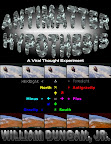Popular representations of the Uncertainty Principle that incorporate the “observer effect” are disingenuous. No observer can exist at the subatomic level. Only measurements can be made, and any object being measured cannot be isolated from the act of measurement nor its surrounding environment.
Let's devise a popularized account of the Uncertainty Principle that eliminates this misrepresentation. However, instead of imagining ourselves as an observer at the subatomic level, which is problematic, let's imagine the subatomic level enlarged to our size, where we must lose our normal senses that do not exist at the subatomic level. It's easy to imaging a bouncing basketball. The basketball is being dribbled up and down, but in the subatomic context we cannot see it, hear it, or feel any vibrations in the floor or through the air. We cannot observe it, but we can measure either its position or its motion or both with innate limitations as to accuracy.
To do this we need to ricochet something off the basketball. A tennis ball will do, but again in the subatomic context we cannot see the tennis ball either. We can only detect when and where the tennis ball lands. We also know the path of the tennis ball, its initial speed, and when and where it started. To do this, a machine launches a tennis ball and it passes through the path of the basketball. The paths of both balls intersect, and we can measure the amount of time that the tennis ball spends within the path of the basketball. The higher the speed of the tennis ball, the greater the precision we can measure the position of the basketball. However, when the two collide, the tennis ball knocks the basketball so hard that the dribble gets interrupted.
By slowing down the speed of the tennis ball, the less the dribble gets interrupted and we are able to calculate more about the motion of the basketball, but as we do this we sacrifice information about the position of the basketball. To detect where the tennis ball lands, we will employ another analogy in our world. To see the result, we will use a digital camera with a variable exposure time. A fast exposure amounts to the fast tennis ball, whereas a slow exposure amounts to a slow tennis ball.
A fast exposure takes a crisp picture of the basketball, revealing greater accuracy in position, but less information about motion. A slow exposure takes a blurred picture, revealing greater information about motion, but less accuracy about position, as represented in these two images.
 |  | |
| Position | Motion |
|---|









No comments:
Post a Comment